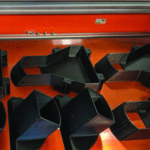Advanced manufacturing firm Fast Radius has just revealed that it has been working with Curtiss Motorcycles on the Zeus 8 electric model. The company will be producing parts for the vehicle using hybrid manufacturing, employing a mix of CNC and Additive methods. Reportedly, Fast Radius are working on over 60 different components of the bike.
“Curtiss’ mission is to ‘create sustainable, desirable, intergenerational, mean, clean, and green future-proof hot rod motorcycles,’” said H. Matthew Chambers, CEO and Chairman of the Board for Curtiss Motorcycles. “Fast Radius’ best-in-class hybrid manufacturing approach and operational efficiencies will enable us to deliver the Zeus 9 on time—satisfying the strong demand from our global audience.”
The production of the bike was much faster with the new methods. From the intricate aluminium and carbon fibre frame to the V8-style battery cylinders, there are over 60 parts produced with a mix of additive manufacturing (AM) and subtractive methods, all within just 12 days.
The companies are currently working on the production of the first 100 bikes in the Zeus 8 line. They unveiled the new model in California last week and are looking at a release date next year. They appear to have extensive plans beyond that as well. The Zeus 8 is a companion piece to future Hades and Eros bikes, both also sporting prominent Greek mythological namesakes.
Bike Components & Hybrid Manufacturing
As Curtiss Motorcycles states, switching modes of manufacturing was about improving and innovating in their design. “Bringing Zeus’ advanced design to life wasn’t easy,” continued Chambers. “We knew that we would need a partner like Fast Radius, who could innovate with us, not just make the parts.”
The use of hybrid manufacturing was crucial in this case since components vastly varied in size and complexity. For larger parts, the companies employed subtractive methods, most notably the 5-axis CNC machine. Complex parts like the Zeus 8’s double-wishbone parallelogram fork required machining from 6061 aluminum to build the girders, for example. The smaller parts were far easier to do with additive manufacturing.

“Our partnership with Curtiss is ideal because it allows them to do what they do best—designing stunning motorcycles—while we do what we do best—matching the project with the right technology and getting quality parts made quickly,” said Brian Simms, VP of Sales at Fast Radius. “We’re looking forward to innovating with Curtiss as they grow their brand.”
The companies are discussing continuing this partnership for future components such as handle grips and seats. Curtiss Motorcycles has significant plans for other models going forward, and from the looks of it hybrid manufacturing is working out just fine for them. We might see more interesting mixes of additive and subtractive manufacturing in their future.
Featured image courtesy of Curtiss Motorcycles.


